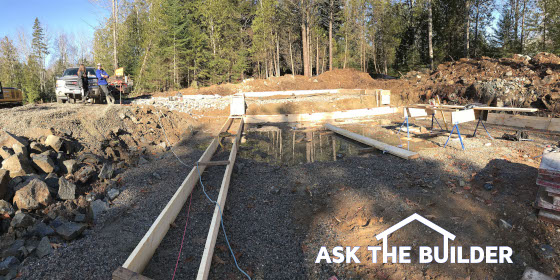New Building Blues
 Building in the late fall where it rains creates all sorts of challenges. (C) Copyright 2018 Tim Carter
Building in the late fall where it rains creates all sorts of challenges. (C) Copyright 2018 Tim CarterBuilding Blues
My oldest daughter and son-in-law are building a new home in Downeast Maine. It’s their first home and you can imagine they’re excited. It’s a good thing they’re young and full of energy because the building process can be stressful and full of surprises.
The project was delayed for any number of reasons, but this isn’t unusual. Perhaps it’s happened to you or might happen should you decide to build a new home. You may have to go back and forth on pricing, your construction loan may take longer to process and close, and your building permit may take a week longer to process than you might like.
The weather can also create delays. Deciding to build in the late fall in Downeast Maine, where rain can happen three times a week, makes it very challenging to get a foundation up and out of the ground. Another key point is you may have a nice surprise under the thin soil as you dig. It’s not uncommon to hit solid bedrock, or ledge as it’s affectionately called by the locals.
When you hit the ledge, it’s time to bring in the blasting boys. This creates an additional delay as local requirements almost always state you have to alert neighbors to give them time to prepare for the ground-shaking experience.
I’ve discovered through the years that the best way to prepare for this mayhem is to create a detailed set of plans and some written specifications. Great plans and specifications become your north star and prevent poor decisions that you might make on a stressful day.
My daughter took the time in the spring to create a very detailed set of plans. I helped her by creating a stack of hand drawings using my colored marking pens. I’ve discovered over the years the use of different colors to represent different building materials helps communicate how things connect to one another.
Architects and builders call these details on building plans. These detailed drawings usually highlight a specific spot or location of the house and put it under a magnifying glass. Looking at one of these details you can almost always visualize exactly how you’re supposed to do something.
Details are very helpful to the tradesmen out in the field. Think of the many details on a set of plans as the step-by-step instructions you might use to assemble a large piece of Scandinavian furniture!
An example of a detail might be how you connect a deck railing post to the floor joists of a deck. The detail would show a specific metal bracket, the through bolts and other smaller bolts that connect the bracket to the post, and other deck framing.
It’s a good idea on your plans to create elevation drawings. These are simple drawings of what a wall might look like in a room as if you took a photo after the house is complete. The elevations might show the exact placement of towel bars, toilet-paper holders, light fixtures, mirrors, and even moldings that might be in a bathroom. You’d even see measurements so things end up exactly where you want them.
The written specifications can prevent arguments and ensure you get great materials on a job. A standard set of plans might just say the builder needs to provide a vapor retarder under a concrete slab. Your idea of a vapor retarder might be far different than what the builder normally installs.
I had my daughter call out a special vapor retarder that meets a specific ASTM standard and is a super high-quality product. It costs just a little more than the crap vapor retarder you might buy at a big box store.
It’s important to realize you shouldn’t wait to pick out the things that will be used on your new home. You might as well pick things out in the planning stage rather than during the job. If the builder and his subs see on the plan the exact fixtures or things you’re using, they can get online at the job site and download special drawings from the manufacturers that show rough openings, the electrical and plumbing connections, and other details that help them save time and your money.
Even with great plans and specifications, there’s going to be some stress. You’ll want to visit the construction site as often as possible to ensure everything is being done as it’s supposed to be. Fortunately, my daughter and son-in-law are staying in a rental home that’s less than ten minutes away. They can stop by each day if they want and I encourage them to do just that and take as many photos as possible to document the work in progress.
You can build a great new home, but please invest the time in a great set of plans and specifications to make the building experience a happy one!
Column 1274